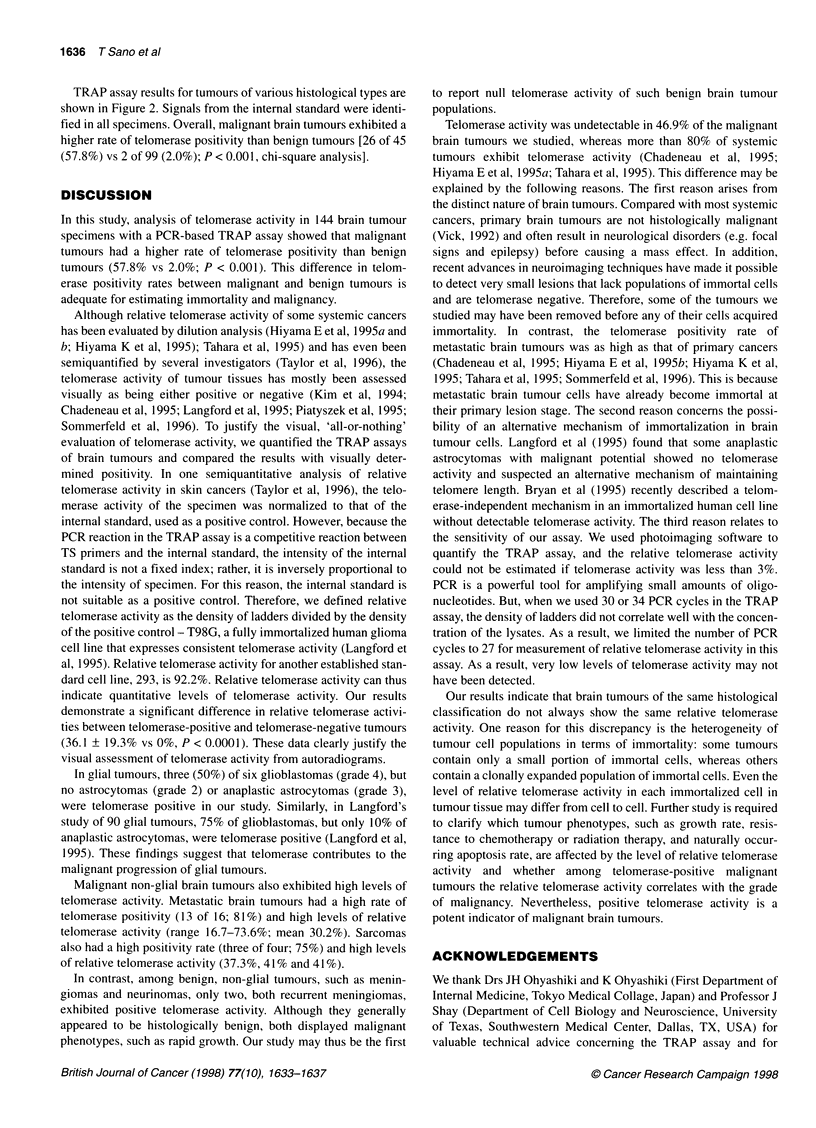Abstract
Unlimited proliferation in immortalized cells is believed to be highly dependent on the activity of telomerase, a ribonucleoprotein that synthesizes telomeric repeats onto chromosome ends. Using a polymerase chain reaction-based telomeric repeat amplification protocol (TRAP) assay, we analysed telomerase activity in 99 benign and 45 malignant brain tumours. The TRAP assay results were quantitated by normalizing the telomerase activity of each specimen to that of human glioma cell line T98G to obtain the relative telomerase activity. Telomerase activity was also assessed visually from the autoradiograms as being positive or negative. One hundred and sixteen tumours with negative telomerase activity had null relative telomerase activity, whereas 28 tumours with positive telomerase activity had relative telomerase activities of 12-84.3% (mean 0% vs 36.1 +/- 19.3%, P < 0.0001). Thus, quantification of telomerase activity confirmed the results of the visual evaluation of telomerase activity on autoradiograms. Based on the assessment, malignant brain tumours had a higher positive rate of telomerase activity than benign tumours (57.8% vs 2.0%, P < 0.001). These data indicate that positive telomerase activity is strongly associated with malignant brain tumours and is rather rare in benign tumours, such as neurinomas or meningiomas.
Full text
PDF




Images in this article
Selected References
These references are in PubMed. This may not be the complete list of references from this article.
- Blackburn E. H. Structure and function of telomeres. Nature. 1991 Apr 18;350(6319):569–573. doi: 10.1038/350569a0. [DOI] [PubMed] [Google Scholar]
- Bryan T. M., Englezou A., Gupta J., Bacchetti S., Reddel R. R. Telomere elongation in immortal human cells without detectable telomerase activity. EMBO J. 1995 Sep 1;14(17):4240–4248. doi: 10.1002/j.1460-2075.1995.tb00098.x. [DOI] [PMC free article] [PubMed] [Google Scholar]
- Chadeneau C., Hay K., Hirte H. W., Gallinger S., Bacchetti S. Telomerase activity associated with acquisition of malignancy in human colorectal cancer. Cancer Res. 1995 Jun 15;55(12):2533–2536. [PubMed] [Google Scholar]
- Counter C. M., Avilion A. A., LeFeuvre C. E., Stewart N. G., Greider C. W., Harley C. B., Bacchetti S. Telomere shortening associated with chromosome instability is arrested in immortal cells which express telomerase activity. EMBO J. 1992 May;11(5):1921–1929. doi: 10.1002/j.1460-2075.1992.tb05245.x. [DOI] [PMC free article] [PubMed] [Google Scholar]
- Greider C. W., Blackburn E. H. Identification of a specific telomere terminal transferase activity in Tetrahymena extracts. Cell. 1985 Dec;43(2 Pt 1):405–413. doi: 10.1016/0092-8674(85)90170-9. [DOI] [PubMed] [Google Scholar]
- Greider C. W., Blackburn E. H. Telomeres, telomerase and cancer. Sci Am. 1996 Feb;274(2):92–97. doi: 10.1038/scientificamerican0296-92. [DOI] [PubMed] [Google Scholar]
- Harley C. B. Telomere loss: mitotic clock or genetic time bomb? Mutat Res. 1991 Mar-Nov;256(2-6):271–282. doi: 10.1016/0921-8734(91)90018-7. [DOI] [PubMed] [Google Scholar]
- Hiyama E., Gollahon L., Kataoka T., Kuroi K., Yokoyama T., Gazdar A. F., Hiyama K., Piatyszek M. A., Shay J. W. Telomerase activity in human breast tumors. J Natl Cancer Inst. 1996 Jan 17;88(2):116–122. doi: 10.1093/jnci/88.2.116. [DOI] [PubMed] [Google Scholar]
- Hiyama E., Yokoyama T., Tatsumoto N., Hiyama K., Imamura Y., Murakami Y., Kodama T., Piatyszek M. A., Shay J. W., Matsuura Y. Telomerase activity in gastric cancer. Cancer Res. 1995 Aug 1;55(15):3258–3262. [PubMed] [Google Scholar]
- Hiyama K., Hiyama E., Ishioka S., Yamakido M., Inai K., Gazdar A. F., Piatyszek M. A., Shay J. W. Telomerase activity in small-cell and non-small-cell lung cancers. J Natl Cancer Inst. 1995 Jun 21;87(12):895–902. doi: 10.1093/jnci/87.12.895. [DOI] [PubMed] [Google Scholar]
- Kim N. W., Piatyszek M. A., Prowse K. R., Harley C. B., West M. D., Ho P. L., Coviello G. M., Wright W. E., Weinrich S. L., Shay J. W. Specific association of human telomerase activity with immortal cells and cancer. Science. 1994 Dec 23;266(5193):2011–2015. doi: 10.1126/science.7605428. [DOI] [PubMed] [Google Scholar]
- Langford L. A., Piatyszek M. A., Xu R., Schold S. C., Jr, Shay J. W. Telomerase activity in human brain tumours. Lancet. 1995 Nov 11;346(8985):1267–1268. doi: 10.1016/s0140-6736(95)91865-5. [DOI] [PubMed] [Google Scholar]
- Morin G. B. The human telomere terminal transferase enzyme is a ribonucleoprotein that synthesizes TTAGGG repeats. Cell. 1989 Nov 3;59(3):521–529. doi: 10.1016/0092-8674(89)90035-4. [DOI] [PubMed] [Google Scholar]
- Ohyashiki J. H., Ohyashiki K., Sano T., Toyama K. Non-radioisotopic and semi-quantitative procedure for terminal repeat amplification protocol. Jpn J Cancer Res. 1996 Apr;87(4):329–331. doi: 10.1111/j.1349-7006.1996.tb00225.x. [DOI] [PMC free article] [PubMed] [Google Scholar]
- Sommerfeld H. J., Meeker A. K., Piatyszek M. A., Bova G. S., Shay J. W., Coffey D. S. Telomerase activity: a prevalent marker of malignant human prostate tissue. Cancer Res. 1996 Jan 1;56(1):218–222. [PubMed] [Google Scholar]
- Tahara H., Nakanishi T., Kitamoto M., Nakashio R., Shay J. W., Tahara E., Kajiyama G., Ide T. Telomerase activity in human liver tissues: comparison between chronic liver disease and hepatocellular carcinomas. Cancer Res. 1995 Jul 1;55(13):2734–2736. [PubMed] [Google Scholar]
- Taylor R. S., Ramirez R. D., Ogoshi M., Chaffins M., Piatyszek M. A., Shay J. W. Detection of telomerase activity in malignant and nonmalignant skin conditions. J Invest Dermatol. 1996 Apr;106(4):759–765. doi: 10.1111/1523-1747.ep12345811. [DOI] [PubMed] [Google Scholar]
- Wright W. E., Shay J. W., Piatyszek M. A. Modifications of a telomeric repeat amplification protocol (TRAP) result in increased reliability, linearity and sensitivity. Nucleic Acids Res. 1995 Sep 25;23(18):3794–3795. doi: 10.1093/nar/23.18.3794. [DOI] [PMC free article] [PubMed] [Google Scholar]



